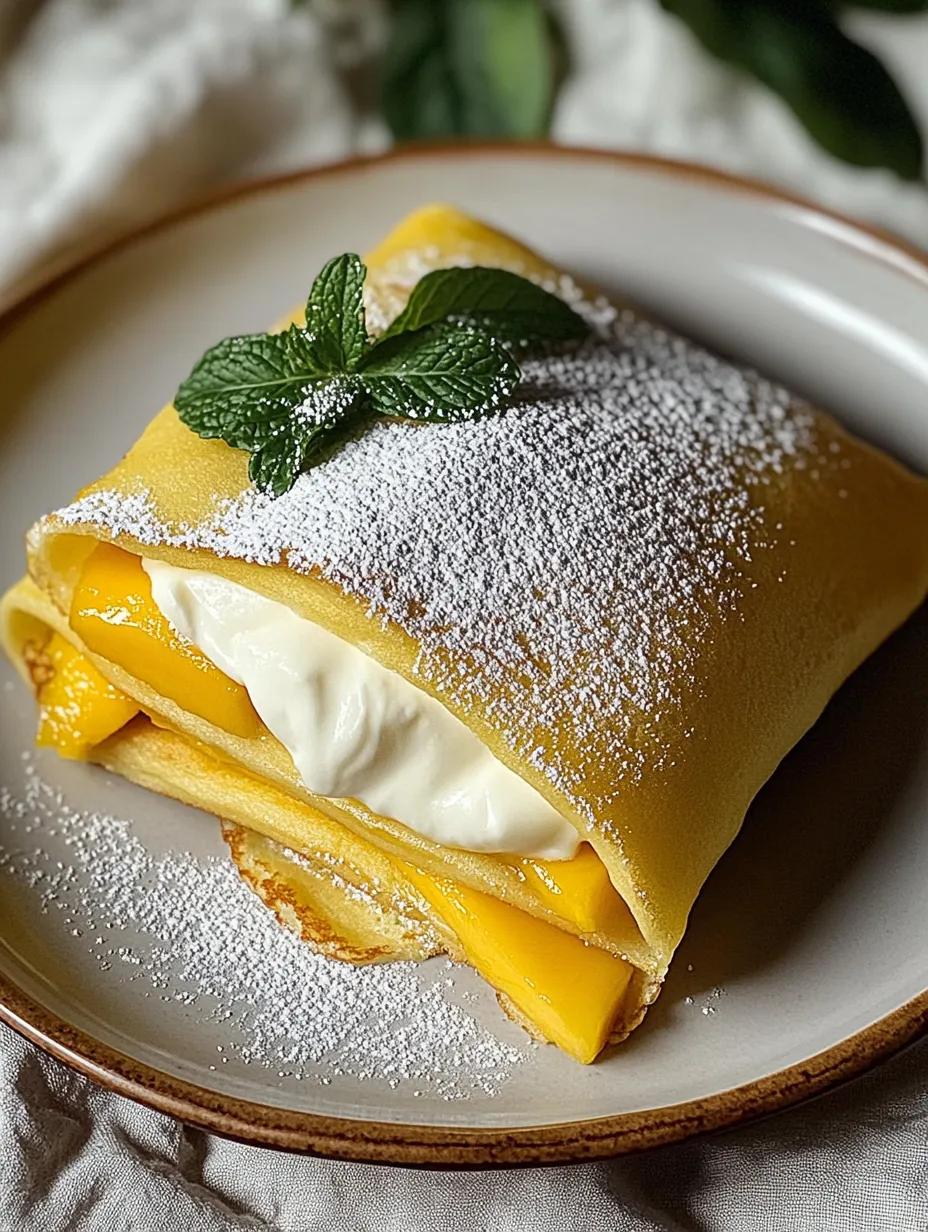 Pin it
Pin it
Mango pancakes offer delicate crêpes wrapped around fresh mango and whipped cream, transforming breakfast into an elegant experience. Inspired by Hong Kong dessert shops, these vibrant parcels balance tropical sweetness with creamy texture, perfect for brunch or dessert.
After a Hong Kong trip, I recreated these at home. Though my first attempt was messy, friends devoured them instantly. Now they're my secret weapon for impressing guests effortlessly.
Essential Ingredients
- Cornflour: Creates silky, tender crêpes
- Fresh mangoes: Alphonso or Ataulfo for optimal sweetness
- Double cream: Whipped to pillowy perfection
- Vanilla extract: Enhances natural flavors
 Pin it
Pin it
Preparation Steps
- Batter Creation
- Sift dry ingredients. Whisk wet ingredients. Combine and strain. Chill 30 minutes.
- Crêpe Cooking
- Cook thin layers one-side only. Stack with parchment to prevent sticking.
- Filling Prep
- Cube ripe mangoes. Whip cream with sugar/vanilla to soft peaks.
- Assembly
- Fill crêpes, fold into parcels. Dust with sugar before serving.
My critical sister-in-law paused mid-bite to request the recipe—proof these pancakes charm even skeptics. Their simplicity makes the praise even sweeter.
Serving Ideas
Pair with jasmine tea for breakfast. Add coconut ice cream for dessert. Create DIY filling stations for gatherings.
Flavor Variations
Substitute berries or caramelized bananas. Add chocolate drizzle. Use cinnamon apples in autumn.
 Pin it
Pin it
Timing Tips
Make batter 24 hours ahead. Prep crêpes hours early. Assemble just before serving.
These became my daughter's birthday tradition. Her joy while assembling them reminds me food creates lasting memories—one folded crêpe at a time.
Frequently Asked Questions
- → What are Hong Kong-style mango pancakes?
- Hong Kong-style mango pancakes are a popular dessert consisting of thin, yellow crepes wrapped around fresh mango slices and sweetened whipped cream. Unlike American pancakes, these are more similar to French crepes but with a signature yellow color. They originated in Hong Kong bakeries and have become famous throughout Asia for their delicate texture and tropical flavor.
- → Why is cornflour (cornstarch) added to the pancake batter?
- Cornflour is added to create a more delicate, tender texture in the pancakes. It helps achieve the characteristic softness and flexibility needed to fold the pancakes without tearing, while also giving them their signature melt-in-your-mouth quality. The combination of plain flour and cornflour creates a perfect balance between structure and tenderness.
- → Can I make these pancakes ahead of time?
- Yes, you can make these mango pancakes ahead of time. You can prepare the crepes a day in advance and store them between sheets of parchment paper in an airtight container in the refrigerator. Once assembled with the filling, they can be kept refrigerated for up to 24 hours. In fact, chilling them for 30 minutes after assembly helps them firm up, making them easier to slice and serve.
- → What's the best type of mango to use for these pancakes?
- Indian or Pakistani mangoes (such as Alphonso or Chaunsa varieties) are ideal for this recipe due to their intense sweetness, fragrance, and smooth texture. However, any ripe, sweet mango will work well. The key is to use mangoes that are ripe but still firm enough to hold their shape when sliced. Ataulfo (honey) mangoes are also an excellent choice as they're less fibrous than some other varieties.
- → Why do I need to sieve the batter?
- Sieving the batter is crucial for achieving the signature smooth, silky texture of these delicate pancakes. It removes all lumps that would create an uneven cooking surface and potentially cause tearing when you fold the pancakes. This step ensures your crepes will be thin, even, and have that professional bakery-quality finish.
- → Can I use other fruits instead of mango?
- Absolutely! While mango is traditional, these pancakes work beautifully with other fruits like ripe peaches, nectarines, apricots, strawberries, raspberries, or cherries. If using berries or cherries, you might want to switch the food coloring to pink or red to complement the filling. The key is to use fruits that are sweet, juicy, and not too watery when cut.
